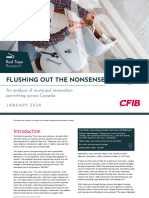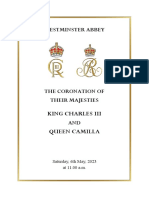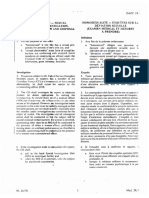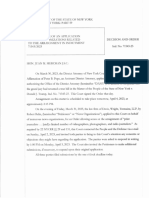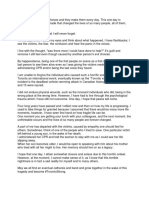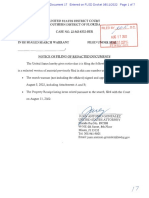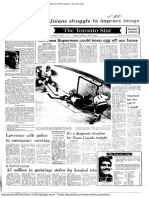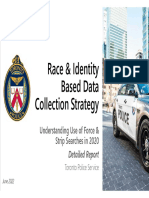Académique Documents
Professionnel Documents
Culture Documents
Bjorkquist Et Al Notice of Application
Transféré par
Toronto Star100%(1)100% ont trouvé ce document utile (1 vote)
54K vues25 pagesCourt files from the Ontario Superior Court of Justice.
Copyright
© © All Rights Reserved
Formats disponibles
PDF ou lisez en ligne sur Scribd
Partager ce document
Partager ou intégrer le document
Avez-vous trouvé ce document utile ?
Ce contenu est-il inapproprié ?
Signaler ce documentCourt files from the Ontario Superior Court of Justice.
Droits d'auteur :
© All Rights Reserved
Formats disponibles
Téléchargez comme PDF ou lisez en ligne sur Scribd
100%(1)100% ont trouvé ce document utile (1 vote)
54K vues25 pagesBjorkquist Et Al Notice of Application
Transféré par
Toronto StarCourt files from the Ontario Superior Court of Justice.
Droits d'auteur :
© All Rights Reserved
Formats disponibles
Téléchargez comme PDF ou lisez en ligne sur Scribd
Vous êtes sur la page 1sur 25
CV -AI-O6 6734/9-wp
Court File No.
ONTARIO
SUPERIOR COURT OF JUSTICE
SARA ANN BJORKQUIST, DOUGLAS ROY BROOKE,
AB (BY THEIR LITIGATION GUARDIAN DOUGAS ROY BROOKE),
PATRICK CHANDLER, PAUL CHANDLER
MN (BY THEIR LITIGATION GUARDIAN PATRICK CHANDLER),
OP (BY THEIR LITIGATION GUARDIAN PATRICK CHANDLER),
EMMA KENYON, MARIAN KENYON, ROGER KENYON,
1J (BY THEIR LITIGATION GUARDIAN EMMA KENYON),
VICTORIA MARUYAMA
CD (BY THEIR LITIGATION GUARDIAN VICTORIA MARUYAMA),
EF (BY THEIR LITIGATION GUARDIAN VICTORIA MARUYAMA),
ALEXANDER KOVACS,
KL (BY THEIR LITIGATION GUARDIAN ALEXANDER KOVACS),
THOMAS SETTERFIELD, TIMOTHY SETTERFIELD,
GH (BY THEIR LITIGATION GUARDIAN TIMOTHY SETTERFIELD),
DANIEL WARELIS, AND WILLIAM WARELIS
Applicants
~and—
ATTORNEY GENERAL OF CANADA
Respondent
APPLICATION UNDER RULES 14.05 OF THE RULES OF CIVIL PROCEDURE
NOTICE OF APPLICATION
TO THE RESPONDENT
A LEGAL PROCEEDING HAS BEEN COMMENCED by the Applicants. The Application
made by the Applicants appears on the following page.
‘THIS APPLICATION will come on for a hearing (choose one of the following)
On person
(By telephone conference
[a By video conference
ona day and time to be set by the registrar.
IF YOU WISH TO OPPOSE THIS APPLICATION, to receive notice of any step in the
application or to be served with any documents in the application, you or an Ontario lawyer acting
for you must forthwith prepare a notice of appearance in Form 38A prescribed by the Rules of
Civil Procedure, serve it on the Applicants’ lawyer or, where the Applicants do not have a lawyer,
serve it on the Applicants, and file it, with proof of service, in this court office, and you or your
lawyer must appear at the hearing.
IF YOU WISH TO PRESENT AFFIDAVIT OR OTHER DOCUMENTARY EVIDENCE TO
THE COURT OR TO EXAMINE OR CROSS-EXAMINE WITNESSES ON THE
APPLICATION, you or your lawyer must, in addition to serving your notice of appearance, serve
a copy of the evidence on the Applicants’ lawyer or, where the Applicants do not have a lawyer,
serve it on the Applicants, and file it, with proof of service, in the court office where the
Application is to be heard as soon as possible, but at least four days before the hearing,
IF YOU FAIL TO APPEAR AT THE HEARING, JUDGMENT MAY BE GIVEN IN YOUR
ABSENCE AND WITHOUT FURTHER NOTICE TO YOU. IF YOU WISH TO OPPOSE THIS
APPLICATION BUT ARE UNABLE TO PAY LEGAL FEES, LEGAL AID MAY BE
AVAILABLE TO YOU BY CONTACTING A LOCAL LEGAL AID OFFICE,
Date: _Leocomper F203] issued by iZeq
Local Registrar
‘Address of SUPERIOR COl COUR SUPERIEURE
OF JUSTICE DE JUSTICE
court office $90 UNIVERSITY AVE. 250, AVE. UNIV
‘LOOR 8E ETAGE
/ERSITY
TORONTO, ONTARIO
ene TORONTO, ONTARIO
TO Minister of Justice and Attorney General of Canada
c/o Deputy Attorney General of Canada
Ontario Regional Office
Department of Justice Canada
120 Adelaide Street West, Suite #400
Toronto, ON
MSH ITI
Tel: 416-973-0942
Via Email: AGC_PGC_TORONTO.LEAD-DCECJ@JUSTICE.GC.CA
1. The Ap
@
(b)
©)
@
©
o
()
APPLICATION
jcants make application for:
An order pursuant to s. 52 of the Constitution Act, 1982 declaring s. 3(3)(a) of the
Citizenship Act,! to be unconstitutional and of no force or effect.
An order pursuant to s. 24(1) of the Canadian Charter of Rights and Freedoms
(“Charter”), declaring that AB, Patrick Chandler, Emma Kenyon, Alexander Kovacs,
Victoria Maruyama, Tim Setterfield, and Dan Warelis are Canadian citizens, as if s.
3(1)(a) of the Citizenship Act applied to them.
An order pursuant to s. 24(1) of the Charter, granting Canadian citizenship to CD, EF,
GH, 1, KL, MN, and OP as ifs. 3(1)(a) of the Citizenship Act applied to them.
‘An order pursuant to s, 24(1) of the Charter, for damages in the amount of $150,000
to CD and EF, in relation to the harm they have experienced for having no choice but
to leave Canada because of the denial of their applications pursuant to s, 5(4) of the
Citizenship Act.
‘An order pursuant to s. 24(1) of the Charter, for damages in the amount of $150,000
to MN and OP, in relation the harm they experienced for being separated from their
father, Patrick Chandler, for one year while their applications for permanent residency
were under review.
Costs of this proceeding.
Such further and other relief as counsel may advise and this Honourable Court may
deem just.
2. The grounds for the Application are:
‘The Applicants
(@)
The Applicants are members of six Canadian families, spanning multiple generations:
the BjorkquisBrooke family (Sara Bjorkquist, Roy Brooke, and AB); the Chandler
"RSC 1985, C29,
()
©
@
©
oO
family (Patrick Chandler, Paul Chandler, MN and OP); the Kenyon/Warelis family
(Emma Kenyon, Marian Kenyon, Roger Kenyon, Daniel Warelis, Judith Warelis,
William Warelis, and J); the Kovacs family (Alexander Kovacs and KL); the
Maruyama family (Victoria Maruyama, CD, and EF); and the Setterfield family
(Timothy Setterfield, Thomas Setterfield, and GH).
The Applicants live across the world, in Canada, Dubai, Hong Kong, Japan, and the
United States of America, What unites them is a common life story.
In all of the Applicant families, one or both parents were Canadian citizens who left
Canada temporarily to pursue valuable opportunities internationally to study or work,
and always intended to return home. While abroad, they had children — the “first
generation born abroad” ~ who obtained Canadian citizenship by descent. The parents
returned to Canada with the first generation born abroad, as small children, and raised
them as Canadians.
In all of the Applicant families, the first generation born abroad grew up in Canada.
They attended Canadian schools and universities, and many worked in Canada ~ some
as civil servants and political staffers. Many of the first generation born abroad have
siblings who were born in Canada and were raised alongside them. Canada is home.
In all of the Applicant families, the first generation born abroad who are now adults
followed in the footsteps of their parents, by temporarily leaving Canada for education
and/or employment, also with the intention to return home. Like their parents, the first
generation born abroad started their families outside Canada. Their children are the
second generation born abroad.
In all of the Applicant families, the first generation born abroad retains strong ties to
Canada. Their extended families (their parents, siblings, and/or their siblings’ children)
live here. They all voted (or attempted to vote) in the 2021 federal election. Those who
have not returned already want the right to return to Canada with the second generation
bom abroad to raise them, and to reunite with their parents and extended family. But
they cannot, because by law they are unable to automatically convey Canadian
citizenship by descent to the second generation born abroad.
The.
@®)
(h)
@
@
(k)
Bjorkquist/Brooke fami
second generation cul off
The legal rule that prohibits the first generation born abroad from automatically passing
on Canadian citizenship to the second generation bom abroad is the “second generation
cut off”, in s, 3(3)(a) of the Citizenship Act, which was added to the Citizenship Act by
Bill C-372
Prior to Bill C-37, the second generation bom abroad automatically obtained Canadian
Citizenship by descent, but ceased to be Canadian citizens at age 28, unle:
they applied
to retain their citizenship and registered as a citizen, and either resided in Canada for at
least a year preceding the date of the application or established “a substantial
connection with Canada”?
Bill
}-37 abolished the “substantial connection” regime and replaced it with the second
generation cut off, a blanket rule that permanently denies to the first generation born
abroad the right to automatically pass on citizenship by descent outside Canada to the
second generation born abroad. The Citizenship Act does not provide any legal
mechanism for the first generation born abroad to remove this restriction on their ability
to transmit Canadian citizenship through descent, no matter how strong their ties to
Canada are.
Bill C-37 created two clas
of Canadian citizenship: one for Canadians born in
Canada, and one for Canadians born abroad. Canadians born in Canada could pass their
citizenship to their children born abroad, but Canadians born abroad could not similarly
do so. As a consequence, the first generation born abroad have a second-class
citizenship because of the circumstances of their birth, which were entirely beyond
their control, and which they are powerless to change.
According to the 2006 Census, there were 173,030 first generation born abroad living
in Canada, all of whom are affected by the second generation cut off.
Sara Bjorkquist, Roy Brooke, and AB
2 an Act to Amend the Citizenship Act, SC 2008, ¢ 15.
2 Citizenship Act, 1974-75-76, ¢. 108, 5.7 (“1977 Citizenship Act”)
oO
(m)
(a)
©)
@)
@
‘handler fan
Sara Bjorkquist and Roy Brooke are both Canadian citizens, on the basis of birth in
Canada. The met in 2001 in Ottawa, while they were both working for the Hon. David
Anderson, Minister of the Environment.
During their time in Ottawa, Sara and Roy developed the desire to gain international
experience and to represent Canada internationally. In 2003, they moved to Geneva,
Switzerland, Sara first worked at the World Health Organization, and Roy initially at
‘the United Nations Environment Programme.
Sara and Roy married in 2004 and decided to start their family in Geneva, and to bring
their children back to Canada to raise them. They did not wish to wait to have children
until they retumed to Canada; Sara was in her early 30’s, and Roy was in his mid-30"s.
The idea of returning to Canada so that Sara could eventually give birth there did not
even occur to them, as the timing of her pregnancy was not predictable and could not
be planned,
Once Sara leamed she was pregnant, there were practical barriers to returning to
Canada to deliver her child. Sara no longer had provincial health insurance and did not
have an obstetrician/gynaecologist in Canada. Air Canada only allows pregnant women
to fly until the end of the 36" week. AB was born by emergency Caesarian section, the
timing for which was impossible to predict.
In 2010, Sara and Roy’s child, AB, was born in Geneva. AB derived Canadian
citizenship by descent from their parents, In 2011, Sara and Roy returned to Victori
British Columbia with AB because they wanted to raise AB in Canada, surrounded by
family and friends.
AB has lived in Victoria ever since, immersed in Canadian culture, surrounded by
Canadian friends and family, and attending Canadian schools. It is the only home they
have ever known. But if AB were to follow in their parents’ footsteps, and leave Canada
temporarily to work or study, they would not be able to convey Canadian citizenship
by descent to any children born abroad
ratrick Chandler, Paul Chandler, MN, and OP.
©
()
o
(u)
)
@&)
)
Paul Chandler immigrated to Canada from Ireland and naturalized as a Canadian
citizen. He met his wife, Janan Chandler (an American citizen), in 1982 in Tripoli,
Libya. They had both temporarily moved to Libya to work as teachers and had been
provided work visas by their employer. Neither had any intention of staying in Libya
Jong term, In 1986, they mai
Paul and Janan decided to start their family in Libya because of their ages. Janan was
nearly 30 when Patrick was bom, and Paul was close to 46, It made sense to start their
family in Libya, and to bring their children back to Canada to raise them. They did not,
consider returning to Canada for their child’s birth because their lives, incomes and
health care in Libya were stable. As Paul was Canadian, he and Janan knew that their
child would acquire Canadian citizenship by descent,
In 1987, Patrick Chandler was born in Tripoli, He derived Canadian citizenship by
descent from Paul. In 1990, when he was two years old, Patrick returned to Canada.
Patrick grew up in Mississauga, Ontario, He graduated from high school in Toronto
and began an undergraduate degree at the University of Toronto,
In 2008, Patrick decided to follow in his parents’ footsteps and work abroad
temporarily, to gain international experience. He never intended to permanently
emigrate.
Patrick moved to China, He worked at a restaurant, and later began teaching English in
Beijing.
Later that year, Patrick met his wife, Fiona, a Chinese citizen. In 2009, their child MN
was born in Beijing. Patrick and Fiona were not married at the time, because Fiona was
too young to marry under Chinese law.
MN was born stateles
Because of the second generation cut off, MN had no right to
Canadian citizenship. Because Fiona and Patrick were not married at the time of MN’s.
birth, MN had no right to Chinese citizenship. The fact of MN’s statelessness weighed
heavily on Patrick; at one point, he became suicidal. MN eventually received Irish
citizenship through their grandfather, Paul Chandler,
@®
(aa)
(bb)
(cc)
In 2014, Fiona and Patrick's second child, OP, was born in Beijing. Like MN, because
of the second generation cut off, OP has no right to Canadian citizenship.
Fiona and Patrick decided to return to Canada to raise their children in a multicultural
society, and for educational and environmental reasons,
Patrick returned to Canada in 2017, without his family, to accept a position as a public
servant i
British Columbia. He decided not to bring his children to Canada on visitor’s
visas because they would not have had provincial health insurance, nor any right to
attend public schools, He submitted their applications for permanent resident status
immediately upon arrival in Canada, In 2018, these applications were granted,
Patrick and his children were separated from each other for 12 months at a crucial age
of their development: OP was 4 years old, and MN was 9 years old. This year-long
separation had a very negative impact on the wellbeing of all of them. Patrick was
forced to miss milestone moments and holidays with his family. It was difficult to
maintain a healthy relationship over Skype, due to the time difference and ineffective
technology. During a brief visit to China during their year apart, it became apparent to
Patrick that his children had suffered deeply from their separation,
Kenyon/Warelis family: Emma Kenyon, Daniel Warelis & 1J, Marian Kenyon & Roger Kenyon,
& William Warelis
(dd)
(ee)
(f)
(gg)
Emma Kenyon and Dan Warelis are Canadian citizens, They are married and live in
Hong Kong. Their child, IJ, was born on 5 December 2021.
Emma’s parents, Marian and Roger Kenyon, were naturalized as Canadian citizens in
1975 and were married in 1981. Their daughter Fiona was born later in 1981.
In 1985, Roger moved with Marian and their first child to Tokyo, Japan, temporarily
to take up a position with the Bank of Nova Scotia. They always intended to return to
Canada.
Emma Kenyon was bom in 1985 in Tokyo, She had been conceived in Canada, before
her parents moved to Japan. She received Canadian citizenship by descent through her
parents.
(hh)
Gi)
(kk)
ay
(mm)
(an)
(00)
In 1986, Emma and her family returned to Toronto, so that Roger could accept a
position with the Canadian Imperial Bank of Commerce (“CIBC”). Emma was a few
months old,
In 1989, Emma and her family moved to London, England, for Roger to take up a
position at CIBC-Wood Gundy. In 1992, Emma and her family moved back to Canada.
She was six years old.
Emma attended primary school, CEGEP and university in Canada. She worked in the
public sector, at Correctional Services Canada, the National Parole Board, the Refugee
Affairs Branch of Citizenship and Immigration Canada, and Cancer Care Ontario.
Dan’s father, William (“Bill”) Warelis, is a Canadian citizen on the basis of birth in
Canada, His mother, Judith Warelis, was born in England and emigrated to Canada,
Bill and Judith were married in 1981.
In 1984, Bill and Judith moved to New York, NY, temporarily to pursue employment
opportunities at Hill and Knowlton Strategies (Bill) and the United Nations (Judith)
Bill and Judith decided to start their family in the United States because of their ages:
Bill was 30 and Judith was 31. They always intended to return to Canada to raise their
children, There were many benefits to not returning to Canada for the birth. For
example, Judith was granted a three-month paid maternity leave from the United
Nations,
In 1985, Daniel (“Dan”) Warelis was born in New York. He received Canadian
citizenship by descent through his father.
In 1986, Dan and his family moved to London, England, so that Bill could accept a
position with Kingsway Public Relations,
In 1991, Dan and his family moved to the United States, so Bill could accept a position
at Imperial Chemical Industries Americas. In 1993, Bill returned to Canada to work at
Cohn and Wolfe. Dan and the rest of his family returned to Canada in 1994. Dan was
eight years old.
(pp)
(ss)
ww
(au)
(wy)
Dan attended primary school, high school and university in Canada, Like Emma, he
worked in the public sector, at the federal Ministry of Public Services, the Canadian
Embassy to Argentina in Buenos Aires, Global Affairs Canada, and the Standards
‘Council of Canada.
Emma and Dan met in 2010, when they were both graduate students at the University
of Ottawa,
In 2016, Emma and Dan travelled to Hong Kong, and decided to stay for a few years
to work. They never intended to leave Canada permanently. It was always their plan to
gain valuable international work experience and then return home, as their parents had
done.
In 2017, Emma and Dan began trying to have a baby. At the time, Emma and Dan were
oth 32. It made sense to begin their family in Hong Kong, and then return to Canada
to raise their child there, close to their parents. In 2018, they married,
It has been extremely difficult for Emma and Dan to conceive a child. Since 2019,
Emma has undergone several rounds of in vitro fertilization (“IVF”) therapy in Hong
Kong. Emma lost her first pregnaney in April 2020. Due to the economic downtown
from COVID-19, they decided it was unwise to move back to Canada without
employment in hand and because they wanted to continue with the IVF process, wihich
is extremely expensive. Emma’s second pregnancy was confirmed in April 2021.
IJ was born on 5 December 2021 and is stateless. Under Hong Kong Law, IJ has no
right to Hong Kong or Chinese citizenship. Emma does not have Japanese citizenship
to convey to IJ, Dan could claim American citizenship but cannot transmit it by descent
to LJ because he does not meet the “substantial connection” requirement under
American law,
Emma and Dan decided to proceed with Emma's pregnancy in Hong Kong,
notwithstanding that their child would be stateless, because of potential health and
financial difficulties if they travelled back to Canada for her to deliver. Since they are
not Ontario residents, her pregnaney would not be covered by the provincial health
insurance plan. They would also have to find a new doctor as non-residents during the
10
(ww)
COVID-19 pandemic, whereas in Hong Kong she is under the care of a fertility doctor
and obstetrician who understands her medical history and can adjust her [VF treatment
as needed. They also considered the enormous challenges Emma had in becoming
pregnant; the complexities and safety issues related to traveling during the COVID-19
pandemic; and the relatively short maternity and paternity leaves in Hong Kong (14
weeks for maternity leave and five days for paternity leave), which would make it
difficult for them to return to Canada for the delivery.
As soon as her second pregnancy was confirmed, Emma took conerete steps to secure
Canadian citizenship for her child, to ensure they would not be stateless. She wrote to
the Canadian High Commission in Hong Kong, who suggested she “consult your doctor
and airline to see if you are suitable to travel back to Canada due to your pregnancy
because to enter Canada, vaccination is not required.” She received similar advice from
the Office of a Member of Parliament.
Kovacs family: Alexander Kovacs and KL
6x)
oy)
(2)
(aaa)
(bbb)
(coe)
Alexander Kovacs’ father was born in Hungary, immigrated to Canada and naturalized
as a Canadian citizen, Alexander's mother had Canadian citizenship based on birth in
Canada. His parents were married in 1953. They had three sons in Canada,
In 1965, Alexander's parents and brothers moved to Libya, so that his father could
accept an offer of employment with Mobil Oil as an aircraft pilot. His parents never
had.the intention of leaving Canada permanently. Their plan was always to return to
Canada with their family. This post was simply a steppingstone for his father’s career.
In 1968, the family moved to the Netherlands, with the intention of setting up the
family’s return to Canada, and with no intention to emigrate,
In 1972, Alexander was bom in the Netherlands.
In 1980, at age cight, Alexander returned to Canada with his mother.
Alexander attended high school and CEG)
P and studied hotel management.
In 1997, Alexander moved to Hong Kong to take up a management position in quality
assurance at Cathay Pacific Catering Services Ltd., on a two-year contract. At no time
WW
(ddd)
(eee)
(a)
(ges)
(hhh)
Gi)
did he intend for bis move to Hong Kong to be permanent. He moved temporarily to
gain international experience and pursue a job that seemed like a good opportunity,
with the goal of eventually returning to Canada. He has always looked for employment
opportunities back in Canada but has not been able to find a suitable position.
In 2004, Alexander met his wife, Irene, who is an Indian citizen by birth. Alexander
and Irene were married in 2010.
In 2011, Irene discovered that she was pregnant. Their child had been conceived in
Canada, while Irene and Alexander were on vacation,
Irene and Alexander actively investigated the possibility of Irene returning to Canada
to deliver, so that their child could have Canadian citizenship. They concluded that it
was impossible for Irene to retum to Canada to give birth, Irene would not have
provincial health insurance in Canada and was unsuccessful in her attempts to find an
obstetrician/gynaecologist at her stage of her pregnancy. Irene was employed full-time
in Hong Kong and had to work right up until her due date, Alexander and Irene did not
feel comfortable with Irene flying internationally after a certain point during the
pregnancy. Alexander would not have been able to return with her to Canada for the
delivery, because he could not take sufficient vacation time, and because of the
uncertainty surrounding the timing of the birth,
In 2011, their child KL was born in Hong Kong.
In 2019, Alexander, Irene and KL temporarily relocated to Dubai, United Arab
Emirates. China’s influence on Hong Kong had begun to negatively affect Alexander's
work. He was particularly concerned about Hong Kong’s National Security Law. In
2018, when Michael Kovrig and Michael Spavor were taken as political hostages by
the Chinese government, Alexander began to feel vulnerable and unsafe in Hong Kong.
Since moving to Dubai, Alexander’s fears about raising his family in Hong Kong, and
his desire not to return, have only become deeper, because of official travel advisories
issued by the Government of Canada.
Alexander's right to reside in Dubai with his family is based solely on his employment.
Alexander and his family want to return to Canada, and ideally at a time when KL is
12
Maruyama family: Victoria Maruyama, CD, and
i)
(kkk)
au
(mmm)
(nnn)
(000)
(ppp)
(aaa)
still at school age so that they will have a chance to strengthen their roots to Canada
and build long lasting friendships
Victoria’s father was born in Vietnam, immigrated to Canada, and acquired Canadian
citizenship through naturalization, He moved to Hong Kong for work, where he met
Victoria’s mother, They were married in 1976.
In 1979, Vietoria was bom in Hong Kong. She received Canadian citizenship by
descent through her father
In 1980, when she was only a year old, Victoria and her family retuned to Canada
‘Victoria attended primary school, secondary school, and university in Canada,
In 2001, like many other recent Canadian university graduates, Victoria moved to Japan
to teach English. She never had the intention to emigrate from Canada, She went to
Japan temporarily, to eam money to pay off her student loans, to gain international
work experience, and to travel.
In 2002, Victoria met her husband, a Japanese national. They were married in 2007.
In 2008, Victoria became pregnant with her first child. She and her husband had
decided to start a family for a number of reasons. She was 29 and did not want to put
off having children. Victoria and her husband had a stable life with steady incomes,
and her employer provided maternity leave. However, before her first child was born,
Victoria always knew that she wanted to raise her children in Canada surrounded by
her family and Canadian culture. To raise her children in Canada, she wanted her
children to have Canadian citizenship.
When Victoria became pregnant, she assumed she could pass on Canadian citizenship
to her children. Citizenship and Immigration Canada (“CIC”) informed her that the
only option for her child to obtain Canadian citizenship was for her to fly back to
Canada to give birth there.
13
(rm)
(sss)
cr)
(uuu)
(ww)
(www)
‘The option of returning to Canada to deliver was completely infeasible. Victoria was
seven or eight months pregnant when she was informed of this option and was worried
about flying. She was not sure that an airline would transport her to Canada. She had
an obstetrician whom she trusted and health insurance in Japan. By contrast, she would
not qualify for health insurance in Alberta until three months after returning, which
would be after her delivery date. Moreover, she did not have an
obstetrician/gynaecologist in Alberta, In addition, she was still working until a month
before her delivery. For financial reasons, she could not simply stop working and fly
to Canada, Her husband would have been unable to accompany her to Canada for the
birth, and it was important to her for him to be there to support her.
In 2009, Victoria’s first child, CD, was born in Japan. In 2011, Victoria’s second child,
EF, was also born in Japan. Victoria remained in Japan for EF’s birth instead of
returning to Canada for similar reasons.
In summer 2017, Victoria and her family arrived in Edmonton to settle, Vitoria and
her husband had decided that moving to Canada was the best thing for CD and EF, who
‘were being bullied at their school in Japan for being mixed race (Chinese and Japanese).
Victoria wanted to bring them up in a multicultural environment that values diversity.
In addition, she felt she had a duty fo care for her older sister, who was extremely ill
and undergoing major surgery.
Victoria’s children arrived on visitors’ visas. She commenced the process of applying
for Canay
citizenship for CD and EF as soon as she arrived, Immigration, Refugees
and Citizenship Canada (“IRCC”) advised her to apply for a grant of citizenship for her
children pursuant to s, 5(4) of the Citizenship Act, which she did in August 2017.
While CD and EF’s applications for Canadian citizenship were pending, Victoria was
intent on them beginning their lives in Canada. The children enrolled in Edmonton
public schools and were eventually able to obtain Alberta health insurance coverage
temporarily.
In July 2018, Victoria and her family had no choice but to return to Japan, because their
visitor's visas had run out and her children’s health insurance coverage had expired. In
4
fall 2018, Victoria and her family returned to Edmonton on Temporary Residence
Permits, and her children attended public schoo! again.
(xxx) In January 2019, IRCC informed CD and EF that their applications for Canadian
citizenship under s. 5(4) of the Citizenship Act had been denied. In February 2019,
Victoria applied for permanent resident status for her children. In July 2019, Vietoria
and her children returned to Japan, because her husband had an offer of employment
there. They would have strongly preferred to remain in Canada but could not because
CD and EF’s s. 5(4) applications had been denied,
(yy) In 2020, CD and EF’s applications for permanent residency were denied. IRCC had
concluded that CD and EF were not serious about being Canadian and had no intention
of returning to Canada.
(zzz) CDand EF feel very Canadian and want to return, They are fluent in English and would
prefer to live in a multicultural society. In Japan, they continue to experience racism,
because they are mixed race and do not speak Japanese perfectly. In addition, CD has
realized they are transgender, which has caused them a great deal of anxiety in a
conservative society. They have engaged in self-harm. CD wishes to come back to
Canada where they can be accepted for who they are.
Setterfield family: Timothy Setterfiel
(aaaa) Thomas (“Tom”) Setterfield was born in Ottawa in 1957 and acquired Canadian
citizenship on the basis of birth in Canada. Penelope (“Penny”) Setterfield was born in
the United Kingdom in 1954. They met backpacking in Thailand in 1982. In 1983, they
were married in Ottawa.
(bddd) In 1984, Penny and Tom moved to Fiji, because Tom was hired as a geologist by
‘Wester Mining Corporation. They viewed their relocation to Fiji as temporary and
never had the intention to emigrate. Penny and Tom decided to start their family in Fiji,
because Penny was 30 and did not have paid work in Fij
(cece) In 1985, Timothy (“Tim”) Setterfield was born in Fiji, He received Canadian
citizenship by descent from Tom,
15
(daddy
(cee)
em
(gege)
(ohhh)
Gi)
(kkk)
ay
In 1988, the Setterfields moved to England so Tom could complete his PhD at the
University of Cambridge.
Tom and Penny never intended on staying in England permanently. There were few
jobs for geologists in England, and Penny could not support the family, because she
was the primary caregiver and could not work outside of the house. It was important
for them to return to Canada to raise their children, for educational and cultural reasons.
In 1991, the Setterfields returned to Canada, for Tom to take up a position as a geologist
in Chibougamau, Quebec. Tim was 5 years old.
‘im attended school and university in Canada.
In 2013, Tim moved to the United States to start his PhD in Aeronautics and
Astronautics at the Massachusetts Institute of Technology. In 2017, Tim accepted a
position at the National Aeronautics and Space Administration’s (“NASA”) Jet
Propulsion Laboratory (“JPL”).
In 2018, Tim married his wife, who is an American citizen, Their child, GH, was born
in the United States in 2020.
When Tim’s wife was seven months pregnant, he learned from an immigration lawyer
that he would not be able to pass on Canadian citizenship to their child. Returning to
Canada for Tim's wife to give birth was not an option. It was unwise for his wife to
travel at that stage of the pregnancy. She would not have been eligible for provincial
health insurance and did not have an obstetrician/gynecologist in Canada, In addi
mn,
JPL’s policies did not permit Tim to work outside the United States for extended
periods of time.
In 2017, Tim applied for the Canadian Space Ageney’s Astronaut Comps, and reached
the final 72 applicants. If the opportunity were to arise again, he would reapply.
‘Tim wants to give the gift of Canadian citizenship to GH for many reasons. He worries
about the effects of climate change making parts of the United States unlivable, and not
being able to bring his family back to Canada in case they need to return. If his parents
become ill, he wants to be able to return to Canada to take care of them without having.
Section 15
to be separated from GH — that is, he does not wish to choose between his obligations
asa son and a father.
(mmmm) The second generation cut off violates the s. 15 of the Charter in relation to the first
(nnn)
generation born abroad.
The second generation cut off draws a distinction among Canadian citizens based
on country of birth —i.e., between those who were born in Canada and those born
in other countries — in relation to the quality of the Canadian citizenship they may
automatically transmit to their children, This distinction is drawn on the basis of
“national origi
an enumerated ground of prohibited discrimination under s. 15.
‘National origin encompasses place and/or country of origin, which in turn includes
country of birth.
b, This distinction is discriminatory because it reinforces, perpetuates, and
exacerbates pre-existing disadvantage. Canada’s citizenship laws have from their
inception disadvantaged children born to Canadians abroad. The 1947 Citizenship
Act ~ Canada’s first citizenship law — denied citizenship to children born abroad
to Canadian soldiers and unwed mothers, which discriminated on the basis of sex
and marital status.‘ These rules were later justified by reference to anxieties
around the changing racial and ethnic composition of Canada, since Canadian
soldiers may have had children with non-European mothers, and therefore
additionally discriminated on the basis of race and nationality. Under the 1977
Citizenship Act, children born abroad to Canadian women continued to have
second-class citizenship, which the Supreme Court struck down in Benner v.
Canada in 1997 as constituting sex discrimination
‘The second generation cut off discriminates on the basis of the intersection of national
origin and sex against women who are first generation born abroad.
* The Canadian Citizenship Act, SC. 1946, ¢. 15, 8.5 (“1947 Citizenship Act")
511997] 1 SCR 358.
7
Vous aimerez peut-être aussi
- ETFO AgreementDocument2 pagesETFO AgreementToronto StarPas encore d'évaluation
- Succession Bingo Board SMDocument1 pageSuccession Bingo Board SMToronto StarPas encore d'évaluation
- 2024-01-29 Municipal Permitting - Flushing Out The Nonsense enDocument37 pages2024-01-29 Municipal Permitting - Flushing Out The Nonsense enToronto StarPas encore d'évaluation
- Nick Nurse Relieved of Head Coaching DutiesDocument1 pageNick Nurse Relieved of Head Coaching DutiesToronto StarPas encore d'évaluation
- Play Dressup With Our Royal Paper DollsDocument2 pagesPlay Dressup With Our Royal Paper DollsToronto StarPas encore d'évaluation
- Application of The Convention On The Prevention and Punishment of The Crime of Genocide in The Gaza StripDocument29 pagesApplication of The Convention On The Prevention and Punishment of The Crime of Genocide in The Gaza StripToronto StarPas encore d'évaluation
- Metrolinx - Metrolinx Statement On Eglinton Crosstown LRTDocument1 pageMetrolinx - Metrolinx Statement On Eglinton Crosstown LRTToronto StarPas encore d'évaluation
- Bulletin Licence PlateDocument1 pageBulletin Licence PlateToronto StarPas encore d'évaluation
- Coronation Order of ServiceDocument50 pagesCoronation Order of ServiceCTV News100% (5)
- Canadian Forces Administrative Order (CFAO 19-20)Document3 pagesCanadian Forces Administrative Order (CFAO 19-20)Toronto StarPas encore d'évaluation
- Pollara EconoOutlook2023Document18 pagesPollara EconoOutlook2023Toronto StarPas encore d'évaluation
- Michele Landsberg Introduces Marian XDocument1 pageMichele Landsberg Introduces Marian XToronto StarPas encore d'évaluation
- Ruling On Access To Trump ArraignmentDocument6 pagesRuling On Access To Trump ArraignmentToronto StarPas encore d'évaluation
- Ruling On Access To Trump ArraignmentDocument6 pagesRuling On Access To Trump ArraignmentToronto StarPas encore d'évaluation
- 2022 Dora Award WinnersDocument7 pages2022 Dora Award WinnersToronto Star100% (2)
- Overview Report: Fundraising in Support of ProtestorsDocument61 pagesOverview Report: Fundraising in Support of ProtestorsToronto StarPas encore d'évaluation
- Dominic Cardy's Resignation LetterDocument2 pagesDominic Cardy's Resignation LetterToronto StarPas encore d'évaluation
- Ontario Deaths in Custody On The Rise 2022Document16 pagesOntario Deaths in Custody On The Rise 2022Toronto StarPas encore d'évaluation
- Sept. 7 Toronto StarDocument1 pageSept. 7 Toronto StarToronto StarPas encore d'évaluation
- COVID-19 PANDEMIC - Specific COVID-19 Benefits - AG ReportDocument92 pagesCOVID-19 PANDEMIC - Specific COVID-19 Benefits - AG ReportToronto StarPas encore d'évaluation
- Affidavit For The FBI Search of President Donald Trump's HomeDocument55 pagesAffidavit For The FBI Search of President Donald Trump's HomeTrisha Powell CrainPas encore d'évaluation
- Letter Bill 39Document1 pageLetter Bill 39Toronto StarPas encore d'évaluation
- Exhibit # 4 - Doc - Victim Impact Statement From T.kuuzUZDocument2 pagesExhibit # 4 - Doc - Victim Impact Statement From T.kuuzUZToronto StarPas encore d'évaluation
- Our Campus, Our SafetyDocument44 pagesOur Campus, Our SafetyToronto Star100% (2)
- Search Warrant MALDocument7 pagesSearch Warrant MALpelofskyj100% (1)
- Exhibit # 5 - Doc - Victim Impact Statement From S. MACKAYDocument1 pageExhibit # 5 - Doc - Victim Impact Statement From S. MACKAYToronto StarPas encore d'évaluation
- Letter To Minister Downey Re Bingo Halls and OLGDocument3 pagesLetter To Minister Downey Re Bingo Halls and OLGToronto StarPas encore d'évaluation
- Toronto StarDocument1 pageToronto StarToronto StarPas encore d'évaluation
- Toronto Police Report On "Systemic Racism" in Officer Use of Force and Strip SearchesDocument119 pagesToronto Police Report On "Systemic Racism" in Officer Use of Force and Strip SearchesToronto Star100% (2)
- Exhibit # 9 - Doc-Victim Impact Statement From M. JUSTINODocument2 pagesExhibit # 9 - Doc-Victim Impact Statement From M. JUSTINOToronto StarPas encore d'évaluation
- Shoe Dog: A Memoir by the Creator of NikeD'EverandShoe Dog: A Memoir by the Creator of NikeÉvaluation : 4.5 sur 5 étoiles4.5/5 (537)
- The Yellow House: A Memoir (2019 National Book Award Winner)D'EverandThe Yellow House: A Memoir (2019 National Book Award Winner)Évaluation : 4 sur 5 étoiles4/5 (98)
- The Subtle Art of Not Giving a F*ck: A Counterintuitive Approach to Living a Good LifeD'EverandThe Subtle Art of Not Giving a F*ck: A Counterintuitive Approach to Living a Good LifeÉvaluation : 4 sur 5 étoiles4/5 (5794)
- The Little Book of Hygge: Danish Secrets to Happy LivingD'EverandThe Little Book of Hygge: Danish Secrets to Happy LivingÉvaluation : 3.5 sur 5 étoiles3.5/5 (400)
- Grit: The Power of Passion and PerseveranceD'EverandGrit: The Power of Passion and PerseveranceÉvaluation : 4 sur 5 étoiles4/5 (588)
- Elon Musk: Tesla, SpaceX, and the Quest for a Fantastic FutureD'EverandElon Musk: Tesla, SpaceX, and the Quest for a Fantastic FutureÉvaluation : 4.5 sur 5 étoiles4.5/5 (474)
- A Heartbreaking Work Of Staggering Genius: A Memoir Based on a True StoryD'EverandA Heartbreaking Work Of Staggering Genius: A Memoir Based on a True StoryÉvaluation : 3.5 sur 5 étoiles3.5/5 (231)
- Hidden Figures: The American Dream and the Untold Story of the Black Women Mathematicians Who Helped Win the Space RaceD'EverandHidden Figures: The American Dream and the Untold Story of the Black Women Mathematicians Who Helped Win the Space RaceÉvaluation : 4 sur 5 étoiles4/5 (895)
- Team of Rivals: The Political Genius of Abraham LincolnD'EverandTeam of Rivals: The Political Genius of Abraham LincolnÉvaluation : 4.5 sur 5 étoiles4.5/5 (234)
- Never Split the Difference: Negotiating As If Your Life Depended On ItD'EverandNever Split the Difference: Negotiating As If Your Life Depended On ItÉvaluation : 4.5 sur 5 étoiles4.5/5 (838)
- The Emperor of All Maladies: A Biography of CancerD'EverandThe Emperor of All Maladies: A Biography of CancerÉvaluation : 4.5 sur 5 étoiles4.5/5 (271)
- Devil in the Grove: Thurgood Marshall, the Groveland Boys, and the Dawn of a New AmericaD'EverandDevil in the Grove: Thurgood Marshall, the Groveland Boys, and the Dawn of a New AmericaÉvaluation : 4.5 sur 5 étoiles4.5/5 (266)
- On Fire: The (Burning) Case for a Green New DealD'EverandOn Fire: The (Burning) Case for a Green New DealÉvaluation : 4 sur 5 étoiles4/5 (74)
- The Unwinding: An Inner History of the New AmericaD'EverandThe Unwinding: An Inner History of the New AmericaÉvaluation : 4 sur 5 étoiles4/5 (45)
- The Hard Thing About Hard Things: Building a Business When There Are No Easy AnswersD'EverandThe Hard Thing About Hard Things: Building a Business When There Are No Easy AnswersÉvaluation : 4.5 sur 5 étoiles4.5/5 (345)
- The World Is Flat 3.0: A Brief History of the Twenty-first CenturyD'EverandThe World Is Flat 3.0: A Brief History of the Twenty-first CenturyÉvaluation : 3.5 sur 5 étoiles3.5/5 (2259)
- The Gifts of Imperfection: Let Go of Who You Think You're Supposed to Be and Embrace Who You AreD'EverandThe Gifts of Imperfection: Let Go of Who You Think You're Supposed to Be and Embrace Who You AreÉvaluation : 4 sur 5 étoiles4/5 (1090)
- The Sympathizer: A Novel (Pulitzer Prize for Fiction)D'EverandThe Sympathizer: A Novel (Pulitzer Prize for Fiction)Évaluation : 4.5 sur 5 étoiles4.5/5 (121)
- Her Body and Other Parties: StoriesD'EverandHer Body and Other Parties: StoriesÉvaluation : 4 sur 5 étoiles4/5 (821)


